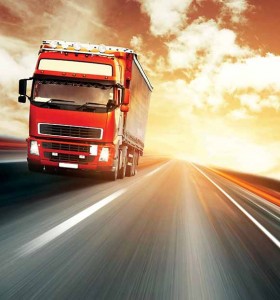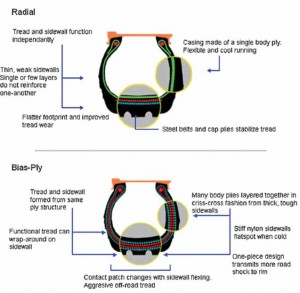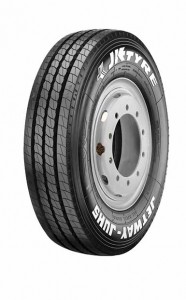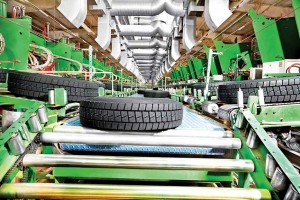Truck and bus radialisation is on the rise, and the future looks bright.
Story by:
Satiish K
It was in 1977, that JK Tyres introduced radial tyre technology in India. It was way ahead of the time, and the tyres failed to strike a cord with the operators. Post the re-introduction of radial tyre in 1999, the going was slow. Truck and Bus Radials (TBRs) were introduced in 1999. During 2005-06, the market share of TBR remained a merge 3-5 per cent of the total Truck & Bus (TB) tyre market. A development that would provide impetus to the growth of TBRs took place in 2005. The Supreme Court passed a judgement which put in place strict guidelines against overloading. At around the same time, tyre companies began aggressively promoting the benefits of TBRs over bias-ply tyres. In over a decade, TBRs have found a calling in the bus industry in a big way. The trucking industry is also embracing radial tyres. With over 65 per cent of the transportation in India taking place by the means of trucks, rising radialisation bids well for the economic growth of the country among other factors like tightening emission norms and rising fuel prices.
Higher operating efficiency
Compared to China, India continues to lack in the proliferation of TBRs. It has taken longer in India for creation of awareness towards TBRs. The proliferation of TBRs could be also linked to rising road infrastructure in the country. This is quite similar to what happened in China. TBR proliferation in China took place on the basis of better road transport infrastructure and the need to attain higher operating efficiency. The need to attain higher operating efficiency is increasingly felt in India too. So, what better way to achieve it than to move to TBRs. Challenges remain, and mainly in the form of a lack of awareness in terms of carrying capacity and cost versus durability. Other two prominent challenges include road conditions and corrupt practices. Considering India’s mission for economic development with a target to increase per capita income by three-four folds by 3032, TBRs are set to contribute a good deal. Radialisation in CVs, it is clear, is unstoppable.
Advantage TBR
Over a bias-ply tyre, a TBR makes better use of the tread portion and side wall structure. The amount to which the sidewall of a TBR can flex is more than that of a bias-ply tyre. This leads to a TBR having better tread patch reach. A TBR shows lesser transverse slip, and is able to transfer more power to the ground over a bias-ply tyre. The flexibility and strength of a TBR, in addition to its advanced construction and compounds, makes for superior shock absorption. The result is an improvement in steering feel and control. TBR presents a better driving experience. The lower rolling resistance of TBR results in better fuel efficiency and lower emissions. If a TBR promises better sustainability, it offers a bigger contact patch with every turn of the tyre. As the tyre turns, there is a certain portion of it that forms the contact patch with the road surface under it. This leads to a certain tendency of the tyre to deform enough. The forces required for acceleration, braking and cornering are transmitted through this ‘contact patch’. The tendency to deform at the point of contact with the road surface leads to the tyre heating up. Some of the energy transmitted by the engine to the wheels also transforms into heat, which has a definitive effect on the life of the tyre as well as its safe operation.
Operating costs
The purchasing cost of a TBR is 18 to 20 per cent higher than that of a bias-ply truck or bus tyre. This is perhaps the most important reason why many truck and bus operators are reluctant to invest in a TBR. What they need to do however is to consider the performance enhancement in terms of wear, rolling resistance, durability and comfort. TBRs offer a significant advantage in terms of the overall operating cost. The retread-ability of TBRs is higher than bias-ply tyres. It is three times that of a bias-ply tyre, and results in a life that is two times more than that of a bias-ply tyre. The consumption of tread rubber in a bias-ply tyre is more than that of a TBR. This often leads to a situation where bias-ply tyres need retreading faster than a TBR would. The fuel cost as well as the running cost per km of a TBR is 5 per cent lower than that of a bias-ply tyre.
Safety
TBRs offer certain safety advantages over bias-ply tyres. They are structurally stronger than bias-ply tyres. As mentioned earlier, they offer better structural strength, more cornering force for better control while cornering and manoeuvring, and less stopping distance because of the larger foot print area (tread contact patch). It may be important to note that TBRs are helping to reduce the burden and cost of accidents and the resulting fatalities.
Rising radialisation
Radialisation in commercial vehicles is on the rise. Both, of the tube type and tubeless type radials. As compared to the level of radialisation in FY2005-06, at 5 per cent, the level of radialisation in FY2014-15 was 25 per cent. As compared to passenger vehicles or cars and SUVs, the rate of radialisation in commercial vehicles may be slow, it is however on the rise. Industry experts estimate that radialisation in CVs will reach 40-50 per cent by 2020. It is catching up with the global pace, they claim. They point at a growing preference of fleets for radials. Fleet operators, the experts explain, are coming to acknowledge the better performance and a distinct cost advantage offered by TBRs. OEMs are also taking to TBRs in a big way as OE fitments. Considering the pickup in demand for TBRs it is but natural for tyre companies to increase TBR capacities.
To help TBRs to penetrate the market further, there is a need to create awareness among commercial vehicle operators. Against the availability of cheaper Chinese imports there is also a need to formulate a policy that would make the domestic players more competitive. Rising access to internet makes it essential that tyre manufacturers tie up with ecommerce sites to offer TBRs at a good price rather than limit their exposure to brick and mortar stores only. This would call for a fundamental change in the way claims are handled, and with a positive view that greater transparency is set in place. TBRs make costly investments, and their take up would help the manufacturers to reduce initial investment costs involved with radial technology plants. Unlike passenger vehicles, commercial vehicles – especially trucks, are prone to overloading. After the apex court banned overloading, instances of overloading have come down. Toll contractors are also ensuring that they do not incur higher maintenance due to overloaded trucks. However, there is a need for a consistent and coordinated effort to ensure that transporters refrain from overloading. They need to be educated about how overloading hampers safety and reliability.
Engineering radials
The lower rolling resistance that radials offer also makes it challenging to engineer them with respect to their performance in other areas like grip and the rate of wear. It is at this juncture that the issue of tyre development and testing is brought to the fore. There is a need for better tyre testing facilities that would help to speed up new product development. The industry, at present, is dependant on Indian test labs with limited facilities, or on European test labs, or on testing with actual customer vehicles, which is both, cost as well as time consuming.
Tyre development & testing
Investments to manufacture radial tyres are rising. There’s however a need to focus on R&D and testing so that the tyres made in India supersede the quality of tyres that are available in other markets. This has to be done at an Indian cost. And, to be more precise, efforts for frugal engineering of tyres are essential. This will be made possible by investing in tyre testing facilities. In India, professional tyre testing facilities are lacking. They are not up to the mark.
The domestic tyre makers have invested significant amounts in new capacities in TBRS over the last several years. As a result, between FY2010 and FY2016, the industry witnessed the completion of investments worth over Rs. 200 billion. The risk of raw material prices moving up remains. There also remains the challenge of combating Chinese imports apart from investing in development and testing facilities. Seeing Rs. 350 billion worth of capacities over the last five to six years, the future of TBR looks bright.
























